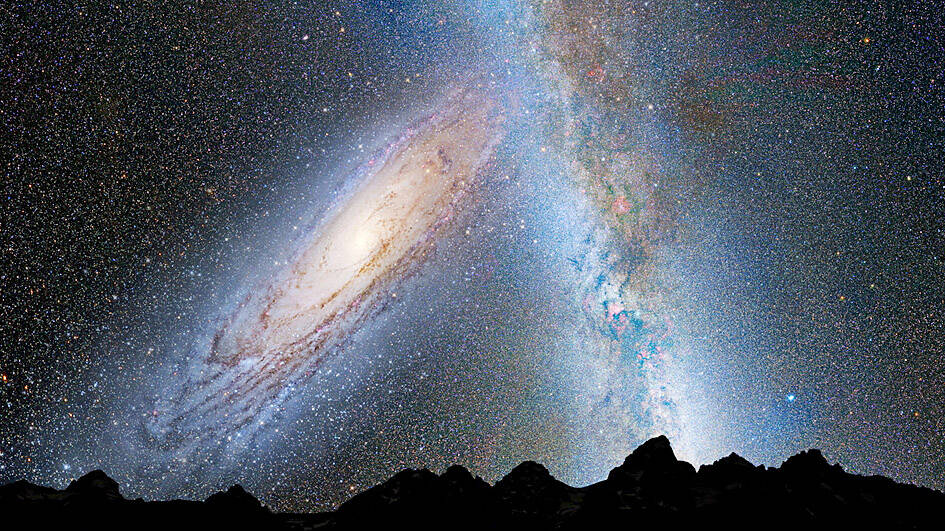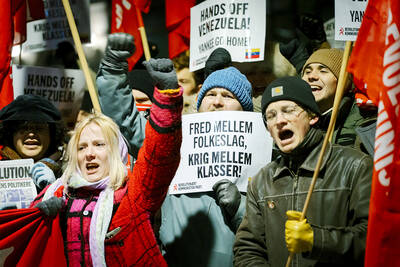It turns out that looming collision between our Milky Way and Andromeda galaxies might not happen after all.
Astronomers on Monday said that the probability of the two spiral galaxies colliding is less than previously thought, with a 50-50 chance within the next 10 billion years. That is essentially a coin flip, but still better odds than previous estimates and farther out in time.
“As it stands, proclamations of the impending demise of our galaxy seem greatly exaggerated,” the Finnish-led team wrote in a study appearing in Nature Astronomy.

Photo: Reuters
While good news for the Milky Way galaxy, the latest forecast might be moot for humanity.
“We likely won’t live to see the benefit,” lead author Till Sawala of the University of Helsinki said in an e-mail.
Already more than 4.5 billion years old, the sun is on course to run out of energy and die in another 5 billion years or so, but not before becoming so big it would engulf Mercury, Venus and possibly Earth. Even if it does not swallow Earth, the home planet would be left a burnt ball, its oceans long since boiled away.
Sawala’s international team relied on the latest observations by NASA’s Hubble Space Telescope and the European Space Agency’s Gaia star-surveying spacecraft to simulate the possible scenarios facing the Milky Way and next-door neighbor Andromeda.
Both already collided with other galaxies in their ancient past and, according to many, seemed destined for a head-on crash.
Past theories put a collision between the two — resulting in a new elliptical galaxy dubbed Milkomeda — as probable if not inevitable. Some predictions had that happening within 5 billion years, if not sooner.
For this new study, the scientists relied on updated galaxy measurements to factor in the gravitational pull on the Milky Way’s movement through the universe. They found that the effects of the neighboring Triangulum galaxy increased the likelihood of a merger between the Milky Way and Andromeda, while the Large Magellanic Cloud decreased those chances.
Despite lingering uncertainty over the position, motion and mass of all these galaxies, the scientists ended up with 50-50 odds of a collision within the next 10 billion years.
“The fate of our Milky Way galaxy is a subject of broad interest — not just to astronomers,” said Raja GuhaThakurta of the University of California, Santa Cruz, who was not involved in the study,
A full-on collision would transform our home galaxy from a disk of stars seen as a milky band of diffuse light across the sky into a milky blob, he said.
A harmless flyby of the two galaxies could leave this stellar disk largely undisturbed, thus preserving our galaxy’s name.
More work is needed before the Milky Way’s fate can be predicted with accuracy, the researchers said. Further insight should help scientists better understand what is happening among galaxies even deeper in the cosmos.
While our galaxy’s fate remains highly uncertain, the sun’s future is “pretty much sealed,” Sawala said.
“Of course, there is also a very significant chance that humanity will bring an end to itself still much before that, without any need for astrophysical help,” he said.

US President Donald Trump on Friday said Washington was “locked and loaded” to respond if Iran killed protesters, prompting Tehran to warn that intervention would destabilize the region. Protesters and security forces on Thursday clashed in several Iranian cities, with six people reported killed, the first deaths since the unrest escalated. Shopkeepers in Tehran on Sunday last week went on strike over high prices and economic stagnation, actions that have since spread into a protest movement that has swept into other parts of the country. If Iran “violently kills peaceful protesters, which is their custom, the United States of America will come to

Auschwitz survivor Eva Schloss, the stepsister of teenage diarist Anne Frank and a tireless educator about the horrors of the Holocaust, has died. She was 96. The Anne Frank Trust UK, of which Schloss was honorary president, said she died on Saturday in London, where she lived. Britain’s King Charles III said he was “privileged and proud” to have known Schloss, who cofounded the charitable trust to help young people challenge prejudice. “The horrors that she endured as a young woman are impossible to comprehend and yet she devoted the rest of her life to overcoming hatred and prejudice, promoting kindness, courage, understanding

‘DISRESPECTFUL’: Katie Miller, the wife of Trump’s most influential adviser, drew ire by posting an image of Greenland in the colors of the US flag, captioning it ‘SOON’ US President Donald Trump on Sunday doubled down on his claim that Greenland should become part of the US, despite calls by the Danish prime minister to stop “threatening” the territory. Washington’s military intervention in Venezuela has reignited fears for Greenland, which Trump has repeatedly said he wants to annex, given its strategic location in the arctic. While aboard Air Force One en route to Washington, Trump reiterated the goal. “We need Greenland from the standpoint of national security, and Denmark is not going to be able to do it,” he said in response to a reporter’s question. “We’ll worry about Greenland in

PERILOUS JOURNEY: Over just a matter of days last month, about 1,600 Afghans who were at risk of perishing due to the cold weather were rescued in the mountains Habibullah set off from his home in western Afghanistan determined to find work in Iran, only for the 15-year-old to freeze to death while walking across the mountainous frontier. “He was forced to go, to bring food for the family,” his mother, Mah Jan, said at her mud home in Ghunjan village. “We have no food to eat, we have no clothes to wear. The house in which I live has no electricity, no water. I have no proper window, nothing to burn for heating,” she added, clutching a photograph of her son. Habibullah was one of at least 18 migrants who died